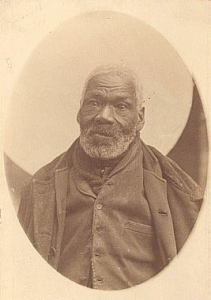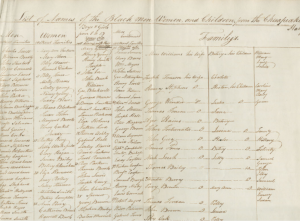
Gabriel Hall
During the War of 1812, at the age of 13, Gabriel Hall escaped slavery and created a successful life for himself in Canada.
Born circa 1801-Died circa 1895
Gabriel Hall was born about 1801 in Maryland. In July of 1814, at the age of 13, Gabriel Hall escaped to the British from his enslavement on Walter Wells‘s farm in Calvert County. At the time of his escape Gabriel was valued at $600. Gabriel ran away from Walter Wells’ plantation with two others, Jane or Jenny Stewart and Aaron Contee as well as Tom Sewell or Morgan, owned by James Duke. At the time of their escape, Southern Maryland was engulfed in the War of 1812. A British squadron was visible from Wells’s property, and British ships were blockading the Patuxent River about one and a half miles away.
In 1815, after the war ended, Hall was relocated to Halifax, Nova Scotia by the British. He settled in an area that would become the town of Preston in Halifax. The land was settled by the black refugees who arrived there after the war. Gabriel Hall was listed among the young boys and girls aged 8-13 on the list titled, Return of black people at Halifax arrived from the Chesapeake as well as the Halifax List. (can you find Gabriel Hall’s name in the Return of black people at Halifax… list?)
When he arrived, Hall was too young (14) to take advantage of lands being offered to the formerly enslaved. However, at the age of 21 in 1824, Hall petitioned the President of Nova Scotia for 25 acres of land. He stated in the petition that he was about to be married and had no income. He married a woman named Lucinda who was also from the United States. The family settled in the community of Preston. Hall and his wife were members of the African Baptist church. Lucinda Hall died about 1891. Around 1892, George H. Craig photographed Gabriel Hall when he was 92 years old. Gabriel Hall’s portrait is the only known surviving photograph of a black refugee who resettled in Halifax following the War of 1812. Hall died in Nova Scotia about 1895.
After the war was over, Maryland slave owners filed for reparations to the Department of State over the loss of property. A commission formed to handle the claims decided that Maryland and Virginia petitioners would be compensated $280 for each slave that was lost to the British. In order to receive compensation owners had to prove that the slaves ran away or were carried off by the British. Many of the claims supporting documentation came in the form of depositions given by friends, family, neighbors, and enslaved people. Walter Wells submitted a claim for the loss of his three slaves, including Gabriel Hall. Wells claim was supported by the depositions of John Mackall, Benjamin Parran, John Parran and Thomas R. Wells, all from Calvert County. Wells was awarded $840 for the loss of his slaves.
Archives of Maryland
(Biographical Series)
Additional Resources
Escaped from Calvert County, Maryland, 1814, Gabriel Hall, MSA SC 5496-51053 (maryland.gov)
Picture credits Date: March 1892.
Photographer: George H. Craig
Legacy of Slavery in Maryland: Slavery & the War of 1812 – Calvert County
Claim of Walter Wells, Case 113. Case Files, compiled ca. 1827 – ca. 1828, documenting the period ca. 1814 – ca. 1828. *ARC Identifier 1174160 / MLR Number PI 177 190*. National Archives, College Park.
“Halifax List.” African Nova Scotians: in the Age of Slavery and Abolition. Nova Scotia Archives and Records Management. http://www.gov.ns.ca/nsarm/.
“Return of black people at Halifax arrived from the Chesapeake,” Commissioner of Public Records NSARM RG 1 vol. 305 no. 7 (microfilm no. 15387), http://www.novascotia.ca/nsarm/virtual/africanns/archives.asp?ID=73
Memorial of Gabriel Hall of Preston,” Commissioner of Crown Lands NSARM RG 20 series A, vol. 90 (1824) (microfilm no: 15737) http://www.novascotia.ca/nsarm/virtual/africanns/archives.asp?ID=93
“Gabriel Hall.” African Nova Scotians: in the Age of Slavery and Abolition. Nova Scotia Archives and Records Management. Photograph: George H. Craig NSARM acc. no. 1988-387, NSARM neg. N-728. http://www.gov.ns.ca/nsarm/virtual/Africanns/archives.asp?ID=151&Language=.
